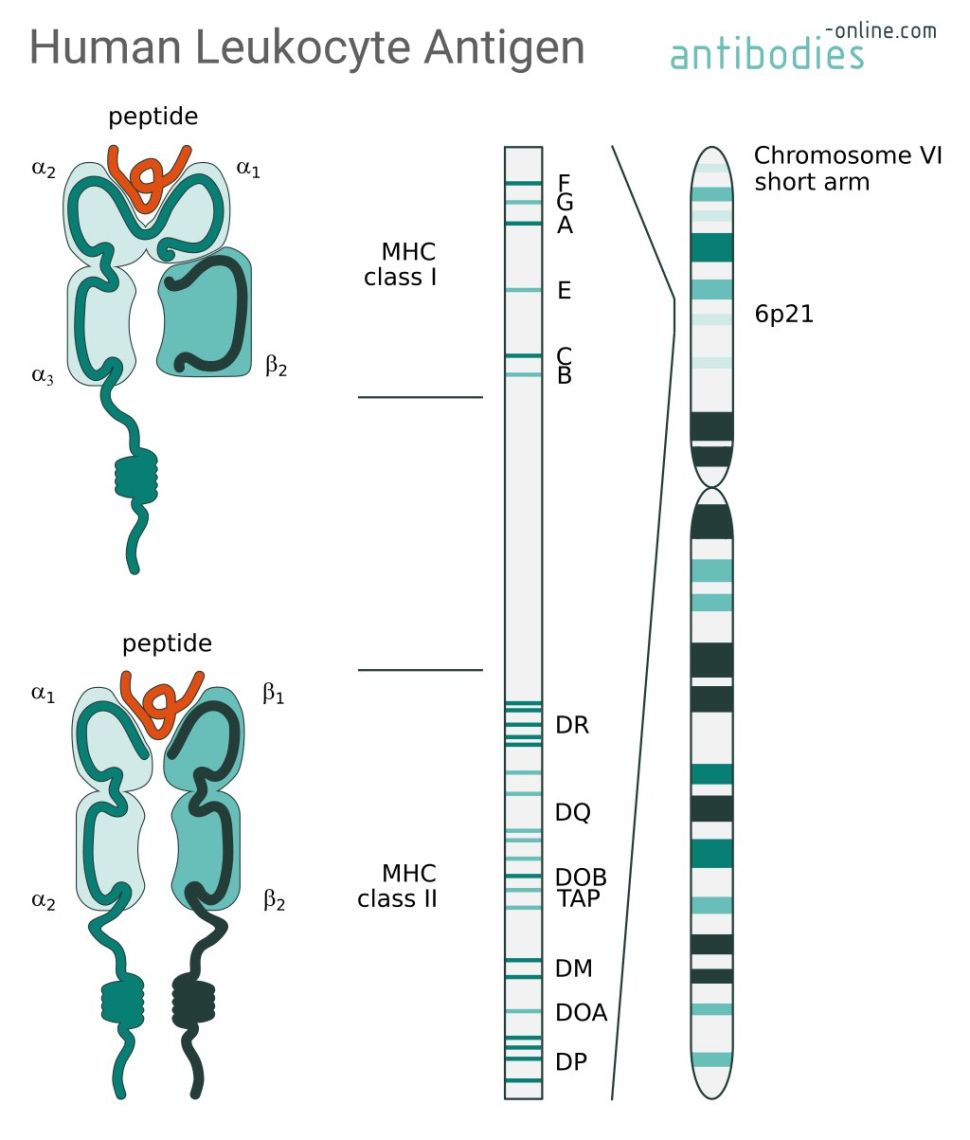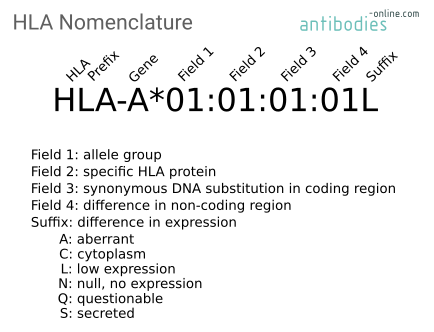Human Leukocyte Antigen
The Major Histocompatibility Complex (MHC) comprises a number of genes that occur in many species. The encoded proteins help the adaptive immune system to tell the body's own proteins apart from those of pathogens such as viruses, bacteria, and protozoans. In humans, MHC proteins are encoded by the Human Leukocyte Antigen (HLA), a group of more than 200 genes located closely together on the short arm of chromosome 6.

Human Leukocyte Antigen (HLA) on human chromosome VI (right and middle). Major Histocompatibility Complex (MHC) class I complexes ar heterodimers of a polymorphic α chain and an invariant β2 microglobulin chain. The α chain subdomains form a groove where peptides are bound and presented to CD8+ cytotoxic T cells. Similarly, the heterodimerc MHC II class complexes present peptides to to CD4+ helper T cells.
MHC class I complexes are heterodimers consisting of a polymorphic α heavy chain and an invariant β2 microglobulin chain (β2m). Genes encoding the α heavy chain are situated within the MHC class I locus whereas the β2 microtubulin genes are typically found outside of this region. The α heavy chain is structurally separated into three N-terminal extracellular domain, α1, α2, and α3, a transmembrane domain, and a short C-terminal cytoplasmic region. Domains α1 and α2 form the peptide-binding groove where peptides from endogenously synthesized proteins are presented to CD8+ cytotoxic T cells. Covalently linked β2m serves as a conformational chaperone enabling peptide binding.
antibodies-online offers high quality recombinant class I HLA proteins and corresponding antibodies. Our HLAs are produced in mammalian cell cultures as recombinant, truncated, soluble proteins, in complex with β2m.
Our Popular HLA Class I Antibodies
- (4)
- (2)
- (1)
- (1)
Our Popular HLA Class I Proteins
MHC class II complexes are heterodimers consisting of two polymorphic chains, α and β, each with two domains. The corresponding genes for both subunits are situated within the MHC class II locus. The peptide-binding groove in MHC class II complexes is formed by domains α1 and β1 and peptides are derived from exogenous proteins and presented to CD4+ helper T cells. Upon binding of the epitope by naïve helper T cells, they are primed and undergo polarization into effector or memory Th or Treg cells.
antibodies-online offers high quality recombinant class II HLA proteins. Our HLAs are produced in mammalian cell cultures as recombinant, truncated, soluble antigens, as zipper-stabilized heterodimers.
Our Popular HLA Class II Antibodies
- (7)
- (5)
- (2)
- (2)
- (1)
Our Popular HLA Class II Proteins
A third cluster of HLAs (MHC class III) between the class I and class II MHC genes encodes components of the complements system and is not involved in the adaptive immune response.
HLA Nomenclature
Each HLA allele has a unique name consisting of the gene name, separated by an asterisk from up to four sets of digits which are separated by colons. Allele names have at least four digits, corresponding to the first two sets designating the allele group and the specific HLA protein. The third and fourth set of digits indicate changes in the DNA sequences in the coding and non-coding regions respectively, that do not influence the amino acid sequence of the protein. They are only assigned if necessary.

HLA alleles are decribed by a unique name identifying the gene, the allele group (field 1), the specific HLA protein (field 2), and changes in the DNA sequence in the coding (field 3) and non-coding (field 4) regions. An additional suffix provides further information regarding protein expression.
HLA typing refers to the process of identifying the specific alleles present at HLA gene loci, which encode cell surface proteins responsible for immune system regulation. Accurate HLA typing is essential for determining compatibility between donors and recipients in organ transplantation and for understanding the genetic basis of various diseases and drug responses.2-field reporting is a HLA typing method that identifies alleles based on their protein sequence differences. This reporting format provides information on the first two fields of the allele designation, i.e. the allele group and the specific HLA protein. 2-field reporting does not include any information about the corresponding DNA sequence. 4-field reporting on the other hand includes all four fields of the HLA allele, including its nucleotide sequence. In a clinical setting, 2-field reporting can sufficiently describe disease associations of particular HLA types or donor-recipient compatibility in a transplantation. 4-field reporting adds additional information which can be in a research setting, e.g. genomics studies.
HLA in Infectious Diseases
Classical class I and class II MHC are leading candidates for infectious disease susceptibility. Many observations point to a major role in determining susceptibility to viral infections. Individuals with the allele HLA-B*46:01 for example have been shown to have the fewest predicted binding peptides for SARS and SARS-CoV-2. A different allele, HLA-B*15:03, shows the greatest capacity to present highly conserved SARS-CoV-2 peptides that are shared among common human coronaviruses, suggesting it could enable cross-protective T-cell based immunity.These observations point towards a potential influence of different HLA composition - the haplotype - in the situations such as the SARS-CoV-2 pandemic. Association of various HLA haplotypes with SARS-CoV-2 susceptibility and the course of COVID-19 could allow strategizing prevention, treatment, vaccination, and optimizing clinical approaches.
Peptide-Free HLA Molecules
Despite the influence of the HLA haplotype, the main determinant of HLA-specificity is the presented peptide. Peptide-free MHC proteins are utilized in various research areas such as structural studies and T cell receptor engineering, to identify potential new drug candidates, in vaccine development, and to explore the functional aspects of MHC molecules. However, MHC molecules are generally not stable in the peptide-free state and must be stabilized.
antibodies-online offers assembled and stabilized peptide-free MHC class I complexes in monomeric and tetrameric formats expressed in HEK-293 cells.
References
- : "HLA and infectious diseases." in: Clinical microbiology reviews, Vol. 22, Issue 2, pp. 370-85, Table of Contents, (2009) (PubMed).
- : "Next-Generation Sequencing Based HLA Typing: Deciphering Immunogenetic Aspects of Sarcoidosis." in: Frontiers in genetics, Vol. 9, pp. 503, (2018) (PubMed).
- : "IPD-IMGT/HLA Database." in: Nucleic acids research, Vol. 48, Issue D1, pp. D948-D955, (2020) (PubMed).
- : "Structures of peptide-free and partially loaded MHC class I molecules reveal mechanisms of peptide selection." in: Nature communications, Vol. 11, Issue 1, pp. 1314, (2020) (PubMed).
- : "COVID-19 infection: the perspectives on immune responses." in: Cell death and differentiation, Vol. 27, Issue 5, pp. 1451-1454, (2020) (PubMed).
- : "Human Leukocyte Antigen Susceptibility Map for Severe Acute Respiratory Syndrome Coronavirus 2." in: Journal of virology, Vol. 94, Issue 13, (2020) (PubMed).
- : "Comprehensive analysis of T cell immunodominance and immunoprevalence of SARS-CoV-2 epitopes in COVID-19 cases." in: Cell reports. Medicine, Vol. 2, Issue 2, pp. 100204, (2021) (PubMed).
- : "Universal open MHC-I molecules for rapid peptide loading and enhanced complex stability across HLA allotypes." in: Proceedings of the National Academy of Sciences of the United States of America, Vol. 120, Issue 25, pp. e2304055120, (2023) (PubMed).

Goal-oriented, time line driven scientist, proficiently trained in different academic institutions in Germany, France and the USA. Experienced in the life sciences e-commerce environment with a focus on product development and customer relation management.
Go to author page



